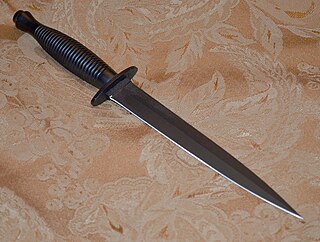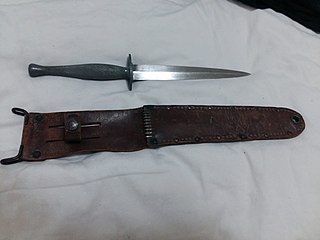The following is a list of notable daggers, either historical or modern. A dagger is a knife with a sharp point designed for fighting.
Military issue or commercial designs, 1918 to present.

A dagger is a fighting knife with a very sharp point and usually one or two sharp edges, typically designed or capable of being used as a cutting or thrusting weapon. Daggers have been used throughout human history for close combat confrontations, and many cultures have used adorned daggers in ritual and ceremonial contexts. The distinctive shape and historic usage of the dagger have made it iconic and symbolic. A dagger in the modern sense is a weapon designed for close-proximity combat or self-defense; due to its use in historic weapon assemblages, it has associations with assassination and murders. Double-edged knives, however, play different sorts of roles in different social contexts.
A sword is an edged, bladed weapon intended for manual cutting or thrusting. Its blade, longer than a knife or dagger, is attached to a hilt and can be straight or curved. A thrusting sword tends to have a straighter blade with a pointed tip. A slashing sword is more likely to be curved and to have a sharpened cutting edge on one or both sides of the blade. Many swords are designed for both thrusting and slashing. The precise definition of a sword varies by historical epoch and geographic region.
This is a list of types of swords.

Filipino martial arts (FMA) refer to ancient and newer modified fighting methods devised in the Philippines. It incorporates elements from both Western and Eastern Martial Arts; the most popular forms of which are known as Arnis, Eskrima, and Kali. The intrinsic need for self-preservation was the genesis of these systems. Throughout the ages, invaders and evolving local conflict imposed new dynamics for combat in the islands now making up the Philippines. The Filipino people developed battle skills as a direct result of an appreciation of their ever-changing circumstances. They learned, often, out of necessity on how to prioritize, allocate and use common resources in combative situations. Filipinos have been heavily influenced by a phenomenon of cultural and linguistic mixture. Some of the specific mechanisms responsible for cultural and martial change extended from phenomena such as war, political and social systems, technology, and trade and practicality.

The katar is a type of push dagger from the Indian subcontinent. The weapon is characterized by its H-shaped horizontal hand grip which results in the blade sitting above the user's knuckles. Unique to the Indian subcontinent, it is the most famous and characteristic of Indian daggers. Ceremonial katars were also used in worship.

Swordsmanship or sword fighting refers to the skills and techniques used in combat and training with any type of sword. The term is modern, and as such was mainly used to refer to smallsword fencing, but by extension it can also be applied to any martial art involving the use of a sword. The formation of the English word "swordsman" is parallel to the Latin word gladiator, a term for the professional fighters who fought against each other and a variety of other foes for the entertainment of spectators in the Roman Empire. The word gladiator itself comes from the Latin word gladius, which is a type of sword.

The English language terminology used in the classification of swords is imprecise and has varied widely over time. There is no historical dictionary for the universal names, classification, or terminology of swords; a sword was simply a single-edged or double-edged knife.
A dirk is a long-bladed thrusting dagger. Historically, it gained its name from the Highland dirk where it was a personal weapon of officers engaged in naval hand-to-hand combat during the Age of Sail as well as the personal sidearm of Highlanders. It was also the traditional sidearm of the Highland Clansman and later used by the officers, pipers, and drummers of Scottish Highland regiments around 1725 to 1800 and by Japanese naval officers.
A stiletto is a specialized dagger with a long slender blade and needle-like point, primarily intended as a thrusting and stabbing weapon.

A pistol sword is a sword with a pistol or revolver attached, usually alongside the blade. It differs from a rifle with a bayonet attached, in that the weapon is designed primarily for use as a sword, and the firearm component is typically considered a secondary weapon designed to be an addition to the blade, rather than the sword being a secondary addition to the pistol. In addition, the two components of these weapons typically cannot be separated, unlike most bayonets mounted on rifles.
The baselard, Schwiizerdolch in Swiss-German is a historical type of dagger or short sword of the Late Middle Ages.
A combat knife is a fighting knife designed for military use and primarily intended for hand-to-hand or close combat fighting.

The Fairbairn–Sykes fighting knife is a double-edged fighting knife resembling a dagger or poignard with a foil grip. It was developed by William Ewart Fairbairn and Eric Anthony Sykes in Shanghai based on ideas that the two men had while serving on the Shanghai Municipal Police in China before World War II.
A misericorde was a long, narrow knife, used from the High Middle Ages to deliver the death stroke to a seriously wounded knight. The blade was thin enough to strike through the gaps between armour plates.

A push dagger is a short-bladed dagger with a "T" handle designed to be grasped and held in a closed-fist hand so that the blade protrudes from the front of the fist, either between the index and middle fingers or between the two central fingers, when the grip and blade are symmetrical.
A knife fight is a violent physical confrontation between two or more combatants in which one or more participants are armed with a knife. A knife fight is defined by the presence of a knife as a weapon and the violent intent of the combatants to kill or incapacitate each other; the participants may be completely untrained, self-taught, or trained in one or more formal or informal systems of knife fighting. Knife fights may involve the use of any type of knife, though certain knives, termed fighting knives, are purposely designed for such confrontations – the dagger being just one example.

The yoroi-dōshi (鎧通し), "armor piercer" or "mail piercer", is one of the traditionally made Japanese swords that were worn by the samurai class as a weapon in feudal Japan.

The United States Marine Raider stiletto was issued to the Marine Raiders and 1st Canadian Parachute Battalion during World War II.

A fighting knife has a blade designed to most effectively inflict injury in close-quarters physical confrontations. The combat knife and the trench knife are examples of military fighting knives.

Mughal weapons significantly evolved during the ruling periods of its various rulers. During its conquests throughout the centuries, the military of the Mughal Empire used a variety of weapons including swords, bows and arrows, horses, camels, elephants, some of the world's largest cannons, muskets and flintlock blunderbusses.